An extinct marsupial hunter only the size of a fox may have hunted prey larger than itself, researchers say.
This predatory ability makes the ancient creature different from its most recent living relative, the also-extinct thylacine, or "Tasmanian tiger." The last known wild thylacine was shot in 1930, and the last captive member of the species died in a zoo in 1936.
Hunting apparently helped drive the Tasmanian tiger to extinction. People targeted them because they believed that the animals killed sheep, but a 2011 study published in the Journal of Zoology knocked down that belief. It determined that the creatures' jaws were too weak to take down large prey, and that they would have only killed animals smaller than themselves.

The new study analyzed an exceptionally well-preserved whole skeleton of an extinct relative of these last thylacines, known as Nimbacinus dicksoni; the specimen was found in the mid-1990s in the Riversleigh World Heritage Area in Australia, and dates to about 11.6 million to 16 million years old.
The marsupial carnivore was about the size of a very large housecat or a small fox, weighing about 11 pounds (5 kilograms). "Its face looked like a cross between a cat and an opossum," said study lead author Marie Attard, a zoologist at the University of New England in Australia. [Marsupial Gallery: A Pouchful of Cute]
The modern thylacine (Thylacinus cynocephalus) was larger, comparable in size to a medium-sized or large dog and weighing in at 40 to 70 pounds (20 to 30 kilograms).
The researchers created a 3-D computer model of the Nimbacinus skull to simulate how the skull may have behaved. Their analysis suggested that it had a powerful bite for its size, was mostly carnivorous and was probably capable of hunting prey larger than itself.
The scientists detailed their findings online Wednesday in the journal PLOS ONE.
— Charles Q. Choi, LiveScience
This is a concensed version of a report from LiveScience. Read the full report. Follow Live Science on Twitter, Facebook and Google+.